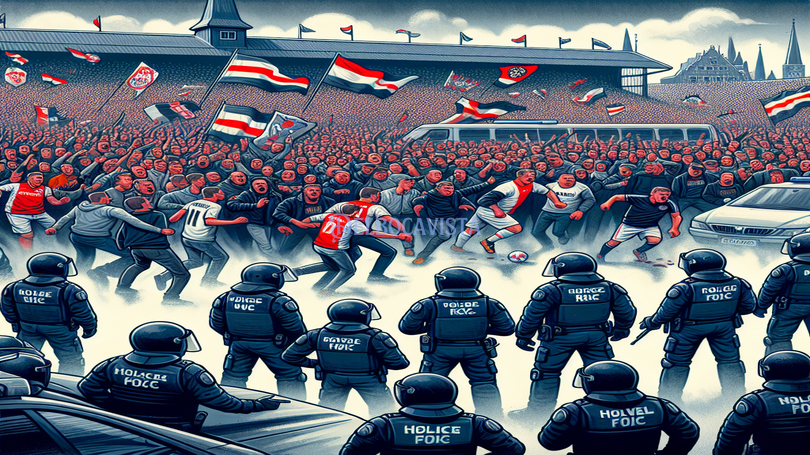Following the conclusion of the football match between RKC Waalwijk and Ajax, a significant disturbance erupted involving supporters of RKC Waalwijk and law enforcement officers. Tensions had been simmering throughout the match, but they reached a boiling point as spectators began to exit the stadium. Approximately one hundred individuals, identified as troublemakers, engaged in aggressive behavior, escalating rapidly into a full-blown confrontation with the police.
These unruly fans, clearly intent on causing mayhem, armed themselves with makeshift projectiles, including stones, metal poles, and even bicycles, hurling these at the police. The attack was sudden and intense, creating a chaotic scene that necessitated intervention by the riot police. The Mobile Unit (ME), equipped and trained to manage such volatile situations, moved in to disperse the crowd and restore order.
Eyewitness reports suggested that the clash began when a contingent of RKC supporters, already frustrated by their team’s performance and the outcome of the match, were provoked further by a small altercation that quickly escalated. The fans grabbed whatever they could find, seeking to vent their anger on the police, whom they perceived as a convenient target. The officers on duty, though prepared for some degree of unrest due to the nature of the event, were initially taken aback by the sheer ferocity and scale of the violence.
The showdown between the unruly supporters and the police was marked by intense efforts to regain control. The ME units, clad in full riot gear including shields and batons, formed defensive lines and utilized various crowd control tactics. These included the use of tear gas and water cannons aimed at dispersing the rioters and preventing further escalation. The sound of police sirens blared through the night, adding to the chaotic ambiance of the scene.
Residents in the vicinity of the stadium experienced significant distress as the conflict spilled over into surrounding areas. Some reported damages to their properties, with windows shattered and vehicles vandalized. The local businesses also suffered as a result, with several shop windows broken and merchandise looted amidst the disorder. The aftermath of the tumult was a street littered with debris, broken glass, and discarded items used as weapons in the melee.
Law enforcement authorities, in an attempt to contain the situation, cordoned off large sections of the stadium vicinity. They established a buffer zone, effectively isolating the hotspot of violence to minimize public risk. This tactical maneuvering was necessary to safeguard uninvolved bystanders and reduce the potential for further spread of the conflict. Meanwhile, reinforcements were rapidly deployed from neighboring precincts to bolster the efforts of the ME on the ground.
The local hospital reported treating several individuals for injuries sustained during the clashes. Some police officers were also among the wounded, having borne the brunt of the attack. The gravity of the incident prompted immediate investigations into the origins of the disturbance and the identification of those involved.
In the immediate aftermath, authorities vowed to bring the perpetrators to justice. CCTV footage, supplemented by recordings from bystanders, was being meticulously reviewed to identify key troublemakers. It was clear that the incident was not merely a spontaneous outburst of aggression but had elements of premeditated hooliganism. The police were confident that arrests would follow swiftly as evidence was gathered and reviewed.
Local government officials condemned the violence in strong terms, emphasizing that such behavior tarnishes the reputation of the vibrant football community. They called for stricter security measures at future matches to prevent a recurrence of such events. There are calls for the football clubs to take a more proactive role in curbing the menace of hooliganism among their supporters.
In conclusion, what should have been an evening celebrating the spirit of sport turned into a chaotic confrontation that brought disruption and distress to a peaceful community. The violent clash between RKC Waalwijk supporters and the police was a stark reminder of the potential for sport-based events to devolve into unruly and dangerous situations. As investigations continue, the focus remains on ensuring accountability and enhancing measures to safeguard public safety in future sporting engagements.

